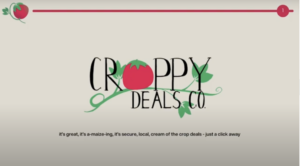Croppy Deal
What it does
Our service aims to provide a decentralized, secure, and convenient marketplace for farmers to sell their goods and for consumers to purchase without worry. Using the Flow blockchain, Farmers will be able to access an immutable sales database that assists with future crop rotation plans. Additionally, consumers will be able to easily purchase produce directly from local farmers, lowering agricultural carbon emmissions due to transport as well as supporting local businesses.
How we built it
We built a React app and used Google Firebase database as a backend. Google Firebase handles sales listings and future iterations of the site will include linking your account with your Flow wallet. Our site uses a domain from GoDaddy and is hosted on Vercel.
Challenges we ran into
- Implementing Flow wallet as a form of authentication
Accomplishments that we’re proud of
- Our name. Croppy Deals is very punny because it sounds like crappy but it’s actually good.
- We drew our logos
What we learned
- How to better concurrently work on the same project without producing conflicting code.
- Implementing Firebase authentication into a live site
What’s next for Croppy Deals
- Implementation of a payment method (Flow)
- Better tracing produce listings towards their providers
- Easy access and readability with purchase data
SkyVet
By: Kevin Lafreniere and Joshua Tapia
Inspiration
Farmers in the Central Valley do not solely rely on their crop harvests for the flow of their income, in fact, they have other means of income– such as the livestock they tend to on a daily basis. However, due to the massive amount of farm animals they tend to; it is quite easy to overlook the animals that need more care. In the end, the ROI rate for their livestock would be less due to the diseases plaguing these animals or simply not being optimal to function (such as Cows producing milk) due to internal issues going on.
Therefore, we wanted to help farmers be proactive in their approach when it comes to caring for the animals– in this case, we have chosen cows. This helps the farmers be more strategic and targeted with their livestock farming to produce a higher success rate in terms of the longevity of the cows overall health. If they can live longer, they become a better investment and friend. Furthermore, this eliminates them from having to manually (and at times, overlook) these issues while also creating a user-friendly model for them to interact technology into their farming.
What it does
SkyVet will use a Tello Education drone with openCV to locate cows and then scan them by utilizing a trained transfer learning model to detect the presence of disease.
How we built it
First, we programmed the Tello SDK to control the drones movement while pairing it with openCV to annotate cows in frame, allowing it to detect the presence of cows.
Afterwards, we employed data found on RoboFlow & Kaggle to train a Transfer learning model based on ResNet50 based on the Keras Library.
Challenges we ran into
Due to the high latency of the Tello drone, there were massive delays in processing movements when adjusting to the cows’ new position.
On top of this, we hit roadblocks on finding datasets depicting various images of cows with diseases. Because how can our model differentiate a healthy cow to a sick one if they don’t know what that looks like?
Accomplishments that we’re proud of
We are happy to have the drone be able to detect cows with high accuracy of 80%, despite some fluctuations that would take it down to 50% and train our own model to identify diseases in leaves which had a testing accuracy of 93.2% and our cow lump identifier had a testing accuracy of 65.5%. Although the testing accuracy is high when we try the identifiers on new data it would be about 50% accurate.
What we learned
Both Kevin and I have learned immensely about Keras and how to train a model. Furthermore, incorporating openCV for object detection for the Tellos SDK. Enabling us to feel more confident to pursue this idea even further with the knowledge we gained.
What’s next for SkyVet
We are hoping to train models for multiple animals and implement ChatGPT to create an user-friendly interface for farmers to use.



